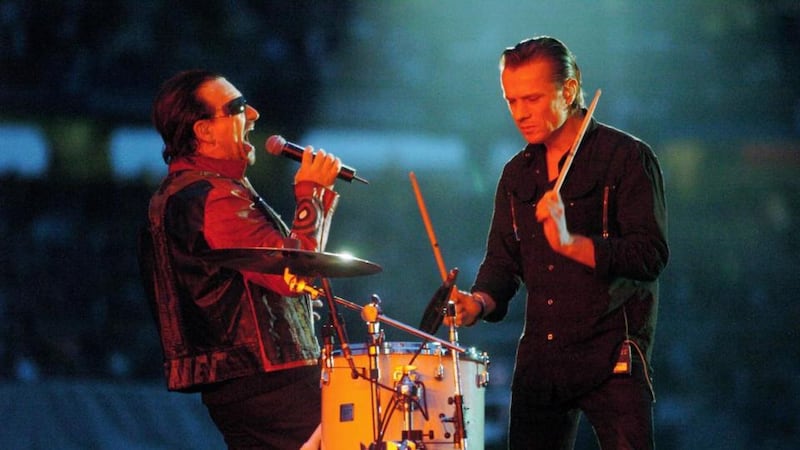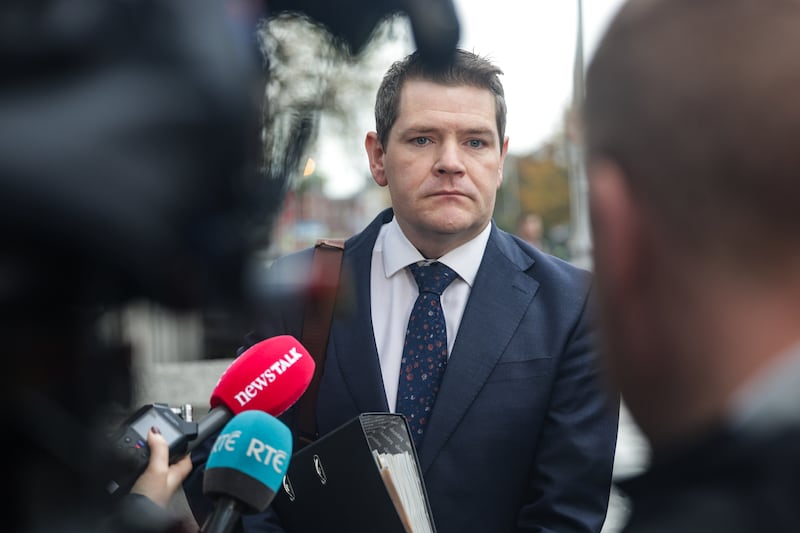Adam Clayton was in a recording studio in London, surrounded by a 20-piece orchestra, when he realised that U2 were in big trouble. “We could read the room. And they were not going, ‘Wow, guys, this is really happening!’” the group’s laconic bassist would recall.
It was late 2003, and the Dubliners were supposed to be applying the final touches to their 11th studio LP, a project that would eventually be released as How to Dismantle an Atomic Bomb. But at that moment it seemed to Clayton that the reverse might be happening. Far from U2 finishing the album, it seemed the record might finish U2. As he surveyed the room of seemingly ambivalent string players, it was obvious to him that Atomic Bomb was in danger of becoming a damp squib.
Back in Dublin that October, he and the band’s drummer, Larry Mullen jnr, were in agreement. After more than a year toiling at their Dublin studio, at Hanover Quay, with the producer Chris Thomas – whose CV included The Beatles’ White Album, Pink Floyd’s The Dark Side of the Moon and Sex Pistols’ Never Mind the Bollocks – it had become clear to them that things weren’t working out. They had an album, but they didn’t have the album, the one that would build on the commercial success of All That You Can Leave Behind, U2′s 2000 blockbuster.
At a terse meeting the duo conveyed the harsh truth to their bandmates, Bono and the Edge: The songs were okay, but okay wouldn’t cut it for U2. “When it comes to signing off on a project,” Clayton explained to Time magazine, “you ask questions like, ‘Have we got a first single to open the campaign?’ Frankly, we were missing more than just a first single.” Mullen agreed: “It was awkward, but it had to be said.”
READ MORE
When How to Dismantle an Atomic Bomb was finally unveiled, in November 2004, it was much closer to the record that Clayton and Mullen had envisaged. They got their singles. Three of them, in fact: Vertigo, City of Blinding Lights and Sometimes You Can’t Make It on Your Own. Plus a fourth if you count the US-only release of All Because of You.
But they also had something else: a second, “shadow” album of tracks that were often of equal quality to the material that made the LP but didn’t align with the overarching themes of spiritual torment and soulful renewal. Several of these outtakes would gain a following among U2 diehards, including Luckiest Man in the World, which was originally called Mercy, and was leaked in 2004, and I Don’t Wanna See You Smile, previously shared via a (since deleted) iTunes U2 box set as Smile.
Two decades on, the “shadow” songs are to finally receive a general release as part of How to Re-Assemble an Atomic Bomb, a 10-track collection that U2 have framed as a clearing of the decks as they gather themselves for the next chapter of their career. Released to streaming on November 22nd, it has been likened by the Edge to applying a lick of “fresh paint” to the band, who recently reconvened for rehearsals in Dublin.
“You have to be fit to play first-touch football,” Bono told Record Collector. “I want to hear the sound of our band in a room … to feel a performance get away from us and be better for that … I experienced it last month with Larry, Adam and Edge, and I want more.”
I would definitely put How to Dismantle an Atomic Bomb in the top five of U2 albums. I think the early 2000s was a very important time for U2. After the very successful comeback in 2000 with All That You Can’t Leave Behind, I think this is a very worthy follow-up
— Brian Mulcair of Zooropa
U2 fans want more, too. But do they necessarily want more of How to Dismantle an Atomic Bomb? Twenty years on, the project remains a curio in the U2 catalogue.
It took up the baton from the rebirth that was All That You Can’t Leave Behind, which Bono had pitched as U2 “reapplying for the job ... of best band in the world”. With 12 million sales and seven Grammys, that album had banished the bad vibes that lingered after Pop, the misfiring 1997 album on which U2 tried to go trip-hop, with disastrous consequences.
But How to Dismantle an Atomic Bomb also marked the start of U2’s slump, a downward spiral that achieved a critical mass with the blindingly beige No Line on the Horizon, in 2009, and which accelerated with the double whammy of Songs of Innocence and Songs of Experience, from 2014 and 2017.
How to Dismantle an Atomic Bomb is the sound of megastars at a crossroads. On one hand it opens with Vertigo, arguably U2’s last great single. But it also contains some of U2’s weakest writing – fillers such as A Man and a Woman and Yahweh, where Bono sounds not unlike Russell Brand’s fake rock star in Get Him to the Greek (“Yahweh, Yahweh/ Always pain before a child is born”). It is U2′s chrysalis moment in reverse: they went into the process as stadium-rock butterflies but came out the other end as caterpillars clinging desperately to old glories.
It is a snapshot of a group caught between iridescence and irrelevance. But there is nonetheless lots about it to cherish, including some of the Edge’s best guitar (that riff on Vertigo) and songs of remarkable soulfulness and melodic deftness (Miracle Drug, about the disabled writer Christopher Nolan, told from the perspective of Nolan’s mother). Its fans love it dearly.
“I would definitely put How to Dismantle an Atomic Bomb in the top five of U2 albums,” says Brian Mulcair of the U2 tribute act Zooropa. “I think the early 2000s was a very important time for U2. After the very successful comeback in 2000 with All That You Can’t Leave Behind, I think this is a very worthy follow-up. As a U2 fan it was a very exciting time, with some great live performances on the BBC and elsewhere and filming their videos in Dublin, even back in Bono’s old home in Cedarwood Road.”
The video shoot at Cedarwood Road, on the northside of Dublin, was connected to Bono’s ongoing grief for his father, Bob, who had died in August 2001, days before the first of two Slane Castle shows. The father-and-son relationship had often been a complex one, especially after Bono’s mother, Iris, died when he was 14. Bob’s cancer diagnosis in the late 1990s had rocked his son, who wrote Sometimes You Can’t Make It on Your Own while his father was still alive and would go on to sing it at his funeral, when it had the working title Tough.
Bob’s shadow hangs heavy over How to Dismantle an Atomic Bomb. The track One Step Closer originated in a conversation between Bono and Noel Gallagher of Oasis, during which Bono wondered aloud if his then seriously ill father still believed in God. Gallagher had remarked that Bob was “one step closer to knowing”. The title of the LP itself refers to Bono’s struggle to come to terms with the loss of his father, the singer would reveal.
“I am the ‘atomic bomb’ that names the CD,” he told Brazil’s Veja magazine. “In August of 2001 my father died of cancer. I was by his side every time I could. I even travelled after U2′s shows from England to stay by his side. But when he died I thought that I could have done more. I became a human bomb. I turned my back to some things and started drinking too much. The record doesn’t have many political songs and more lyrics about my life. My desperations and contradictions are there.”
[ U2 drummer Larry Mullen jnr can’t live with work done on his Howth propertyOpens in new window ]
How to Dismantle an Atomic Bomb was more than a just personal record, however. It arrived at a significant moment for a band that had long combined the private and the political. In November 2004 the United States was still reeling from the September 11th attacks and becoming bogged down in its long war in Iraq. The globe was in turmoil, and that upheaval fed into U2’s writing.
“It’s the first U2 album of a post-9/11 world. The usual themes – life, death, love, hate, war, peace and faith – seem to hit closer to home for fans, because we recently experienced a very emotional and confusing tragedy,” says Hillary Frank, one of the hosts of the U2 podcast The Garden Tarts. (Its name is a reference to a lyric from the U2 song Until the End of the World: “In the garden I was playing the tart.”) “With heavier themes, How to Dismantle an Atomic Bomb is a reminder to fans that we are not alone. Plus, it’s a great rock album.”
Yet, if positively regarded today, the project could easily have been a disaster. That much was clear to Mullen and Clayton as they sat down with Bono and the Edge in 2003 and told them that the project needed a rethink.
Deciding that their collaboration with Chris Thomas wasn’t going as planned, U2 turned to their old wingman Steve Lillywhite, whose relationship with U2 went back to their 1980 debut, Boy. A plain-speaking Englishman with a dry sense of humour, Lillywhite got on well with the earnest Dubliners and wasn’t slow to tell it like it was. For instance, after hearing Bono sing his heart out on Sometimes You Can’t Make It On Your Own, he explained that the tune didn’t work because it lacked a chorus.
Bono responded by picking up an acoustic guitar and, singing in falsetto, improvising the verse that begins, “And it’s you when I look in the mirror …” The song had its hook – and, as Lillywhite had suspected, was 100 per cent better.
The producer enjoyed collaborating with U2 but was always amused by the controlled chaos that followed them. “A lot of the time Bono is writing lyrics to impress the rest of them,” Lillywhite once told me (while talking about No Line on the Horizon, the band’s 2009 album).
“Bono will write some lyrics and maybe Larry or Adam will walk in and say, ‘I’m not really sure I like that line.’ And Bono will change it. And then Edge will walk in and say, ‘What happened to that line? I really liked it.’ So then he’ll change it to a third one. Bono wants all his family to be happy with the lyrics he’s written.”

Hard though it is to believe, the group have never suffered from an excess of self-belief, according to Lillywhite.
“Every record they start, they begin thinking they are the world’s worst band. They have to go and make themselves the world’s best band. It takes a long time to go from the worst to the best within the writing of an album,” Lillywhite says.
“It’s always the case with U2 that they procrastinate and procrastinate until the final deadline comes up. Then they sort of sprint to the finish. There are lot of late nights, a lot of madness.”
An added complication with How to Dismantle an Atomic Bomb was that Bono’s work as a campaigner had started to take up more and more of his time. In 2002 he co-founded the NGO Debt, Aids, Trade, Africa – later renamed One. His advocacy on behalf of debt-ridden African nations would take him to the Oval Office, where George W Bush agreed to a sit-down, and to a photo op with new Russian premier, Vladimir Putin – high-profile meetings that caused unease back in Dublin, where the rest of U2 were working on the record with Lillywhite and his assistant, the Dubliner Garret ‘Jacknife’ Lee.
Still, if Bono’s bandmates were uncomfortable with all the glad-handing, there was an upside: at least he wasn’t annoying them in the studio. “It’s better for Bono not to be here,” Mullen jnr told Rolling Stone.
While Bono pressed the flesh, How to Dismantle an Atomic Bomb was undergoing major surgery. One of the biggest interventions concerned the song that would become Vertigo. The Edge had come up with the riff at his holiday home in Malibu, playing along to a drum loop provided by Mullen.
He presented it to Bono, whose first stab at lyrics was explicitly political. Under the working title Native Son, the song called for the release of the jailed Native American activist Leonard Peltier. A second attempt at nailing the tune had seen Bono sing entirely in Spanish – which explains the “Unos, dos, tres, catorce” countdown that remains in the final version.
“The song was all about gun control – an extension of his political beliefs,” Lillywhite would say. “Bono doesn’t try that kind of thing much any more, but when he does you can feel the ambivalence from the band, and so can he. They want the rock star.”
They kept the riff and the melody and started over with lyrics about Bono’s struggle with the temptations of fame (“All of this, all of this can be yours/ Just give me what I want and no one gets hurt”). With that, Vertigo was born.
Over several painstaking months at Hanover Quay, the rest of the album fell into place – and when it was released, in November 2004, it became a huge hit, as did the follow-up Vertigo tour, which grossed nearly €400 million (the profile of both boosted by a tie-in Apple iPod commercial).
Critically it fared well, too, though reviewers scoffed at Bono’s absurd claim that Atomic Bomb was U2’s first rock album. The consensus was that, after the grand folly of Pop, U2 were now firmly back on track. “Grandiose music from grandiose men, sweatlessly confident in the execution of their duties,” Rolling Stone said. “A band flexing muscles they haven’t used in years,” Uncut agreed.
That enthusiasm was not shared by Bono, who would come to regard How to Dismantle an Atomic Bomb as a missed opportunity. “It’s the best collection of songs we’ve put together,” he would say. “But, as an album, the whole isn’t greater than the sum of its parts, and it f**king annoys me.”
With this month’s new “shadow album”, U2 have an opportunity to right that wrong and present in its totality the body of work they created at the time. It will perhaps serve as a reminder of what U2 are capable of when firing on all pistons, finally closing the door on How to Dismantle an Atomic Bomb and potentially opening a new one as the band turn towards horizons fresh and unexplored.
How to Dismantle an Atomic Bomb (Re-Assemble Edition), featuring How to Dismantle an Atomic Bomb and How to Re-Assemble an Atomic Bomb, is available digitally now, as is the standalone remastered edition of How to Dismantle an Atomic Bomb. How to Re-Assemble an Atomic Bomb is released on vinyl and as a standalone digital edition on Friday, November 29th



















